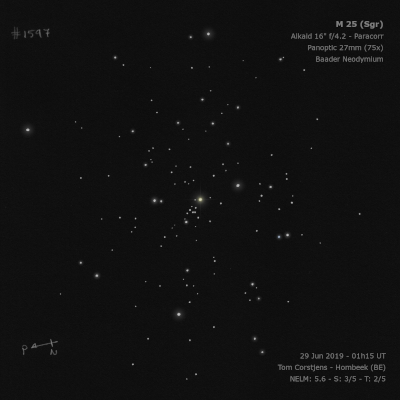
Philippe de Chéseaux discovered M25 = IC 4725 in 1745-46 but it was not included in the GC or NGC despite being independently discovered by Messier in 1764, observed by William and Caroline Herschel in July 1783 ("Very large stars and some small ones; I counted 70, and there are many more within no considerable extent"), Admiral Smyth in 1836 and Reverend Thomas Webb in 1859. Solon Bailey found the cluster on a photographic plate in 1896 using a 1" Cooke lens at the Arequipa station. The discovery was reported in "A Catalogue of Bright Clusters and Nebulae" (Annals of Harvard College Observatory, Vol LX, No. VIII, 1908). Dreyer equated IC 4725 with M25, but though credited Bailey with the position.
400/500mm - 17.5" (8/27/92): about 100 stars in 30' field although fills 45' field at 82x. The densest portion in the center is a group of 7 fairly bright stars situated between two bright stars mag 6.5 (U Sgr) and 8.0 oriented E-W. U Sagittarii (6.3-7.0) is located at the east end and is the brightest star in the cluster. Just south of this group is a long dark lane void of stars oriented E-W that appears darker than the background. Bordering the south edge of this dark lane is an elongated group of 10 stars including Bu 966, a nice evenly matched double star at 11" separation. To the west of this string are two mag 9 and 10 stars oriented SW-NE. The cluster includes several colored stars and is visible naked-eye just south of a mag 5 star.
Naked-eye - (8/31/11): very easy to see as a naked-eye "patch" (total V = 4.6) in a dark sky.
Notes by Steve Gottlieb